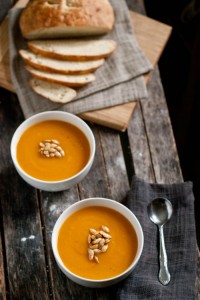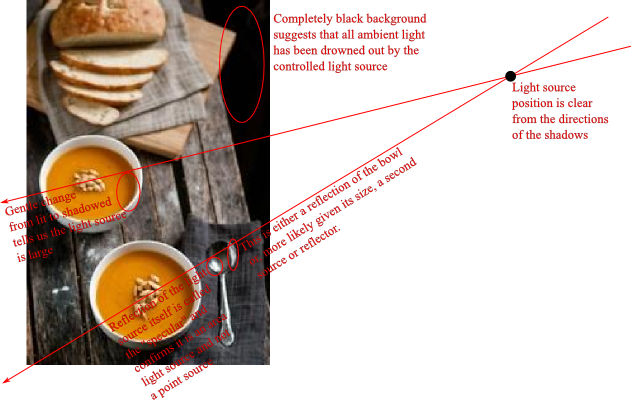My friend Victoria is a photographer. I’m interested in photography too, and like to help her when I can. I noticed that she was researching styles of photography for autumnal, rustic, foods. One example in particular caught my eye.

It caught my eye because it’s the sort of photography I like: a staged scene, that’s made to look professional by careful use of lighting.
It also looks like the sort of thing I could reproduce. This article then is the record of what I did.

Before we can recreate, we need to understand what was done in the original.
-
I’m assuming no photoshopping.
-
The first thing to note is that the very dark background makes us instantly think that ambient light is not a factor here. The other alternative is that a black velvet background has been put under the table, but even then we’d expect ambient light to show that at least a little.
-
If the photo isn’t lit by ambient light, then it must be lit by flash. If we want to know about a light source in an image then we look at the shadows.
-
Look at the shadow cast by the edges of the bowls in their contents. If we look at the direction of the shadow back from each bowl, where they cross is the source of the light. The length of the shadow tells us where in the “sky†the light is – just like daylight, long shadows come when the Sun is low in the sky. Our primary light, or “key†is camera right, fairly high up, giving short shadows.
-
A couple of terms: the “umbra†part of a shadow is that part from which none of the light source is visible. The “penumbra†is that part of the shadow from which some of the light source is visible. The “diffuse†part is where the whole of the light source is visible. The “specular†part is a reflection of the light source itself – depending on the material being lit, this isn’t always visible.
-
The shadow edge tells us about the size of the light source. Or more accurately, the size of the penumbra. If there is no penumbra, then the light is a point source, as the shadow is either present or not present, there is no in-between. If there is a large penumbra then the light source is large because it’s possible for a point in the shadow to be able to “see†any proportion of the light source.
-
In this photograph we can see that the shadow edge is soft, so we have a non-point light source. It’s a (relatively) gradual change from full shadow to no-shadow, so we can say the light source is large.
-
Look at the spoon. Remember that it’s concave as we look at it and so the left of the spoon is reflecting things from the right, and the right of it is reflecting things from the left. The left hand side gives us confirmation that our evaluation that light source is large is right. If it were a point source of light, its specular reflection would be a point. It isn’t, it’s clearly got area – distorted by the curve of the spoon, but an area nevertheless.
-
Importantly, it’s worth noticing that the “umbra†parts of the image, those completely in shadow, are not completely black. That means that they are receiving light from a direction other than the key light axis – this light is called the “fillâ€. There are two possibilities then: either there is a second active light source in use, or the key light is being reflected back from a different direction.
-
Look at the spoon again, this time the right hand side. We see another large specular reflection on the right of the spoon bowl – that cannot be coming from the key light. It’s possible it’s a reflection of the bowl edge, but given the overall lightness of the scene, it’s more likely that we’re seeing the reflection of the fill light, which must therefore be camera left. (Finally in the spoon, if we look at the top of it, we can just about see the reflection of the camera).
-
It’s harder to find clues about this light, because it appears to be much larger, and so we’re not seeing any secondary shadows – they are simply too diffuse. There is evidence for it not being an active light source though – look at the umbra part of the upper bowl’s shadow on the table, they are very dark indeed – if the fill light were active, it would not be possible for the light level to go beneath a certain minimum, and certainly not on the side nearest to that source. If, on the other hand, our fill light is using reflected light from the key light, then in places where objects cast a shadow on the reflector, there would be no fill light in those areas. That’s exactly what we see in those dark areas to the left of the upper bowl.
-
We can also work out something about the focal length chosen: we’re not seeing any serious foreshortening, the lower bowl is closer to the camera than the upper camera, and yet they have a similar apparent size. The spoon doesn’t look massively out of proportion, and yet it is further away from us than the top of the lower bowl. We can conclude then that a wide angle focal length wasn’t used.
-
The aperture is calculable too. The edge of the bread board has clearly gone out of focus compared to the nuts floating on the soup in the bottom bowl. In terms of difference in distance from the camera, we’re only really talking about a foot or so of depth, and yet we’ve got a lot of blurring.
-
Putting the above together, we’re looking at a wide aperture, and a medium focal length. A very large reflector camera left and above the scene for fill light. The key light is a diffused light source camera left, about 30 degrees up from the table.
Phew. That was pretty detailed, but it’s covered pretty much everything we need to know in order to reproduce the photograph.
I’ll cover that photograph in part II.